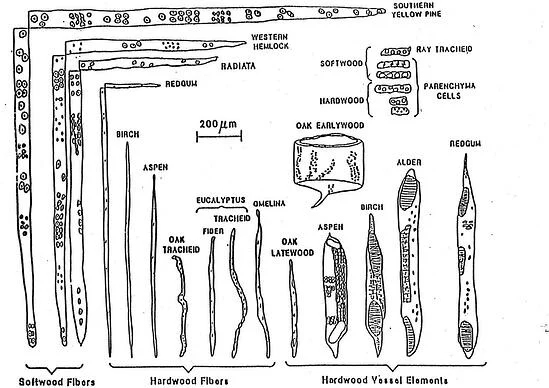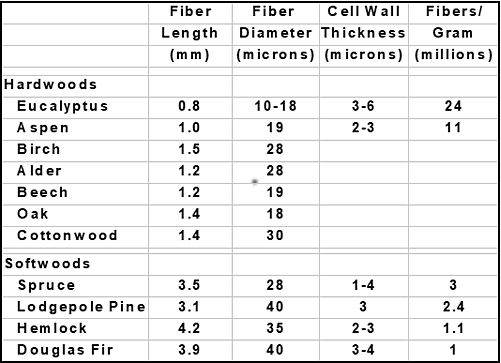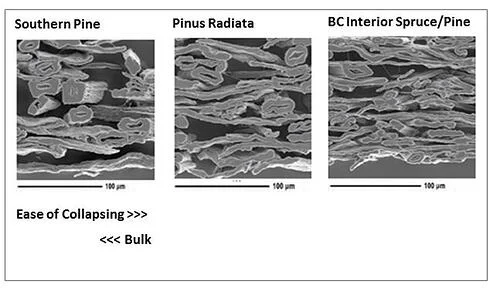We recently discussed the various factors that are impacting market pulp prices. Market pulp is a critical global commodity within the pulp and paper industry as it plays a primary role in manufacturing numerous paper grades.
But what exactly is this product we refer to as “pulp” that we have heard so much about in the last two years?
Let’s take a very simplified look at everything “pulp” and is the key features that major players in the industry seek out.
Pulp and Fiber Properties and Characteristics
All cellulosic pulps are comprised of basically the same materials: cellulose (polysaccharides), hemicellulose, lignin, and extractives. Some of the more common pulp properties used to identify fiber characteristics and potential fiber usage include:
- Fiber Wall Thickness
- Fiber Length
- Fiber Diameter
- Chemical Composition
- Separation process of the fibers from the chip matrix. This includes kraft cooking, sulfite, NSSC, BCTMP, and other high–yield processes, along with the bleaching process for the bleached pulps.
These fiber properties can be used as a guideline to help explain the interaction with other fiber properties that are important to the papermaker and to the final product.
Paper fiber properties that are critical include:
- Drainage- related to Water Retention Value (WRV), porosity, strength development, and population
- Wet Sheet Strength- coarseness, fiber-fiber bonding
- Formation- coarseness, porosity, fiber population
- Water Retention Value- fiber dimensions, fiber wall thickness, and coarseness
- Porosity- coarseness, fiber population, fiber-fiber bonding
- Bulk- fiber diameter, coarseness, fiber wall thickness
- Fiber Stiffness- fiber length, fiber wall thickness
- Opacity Ability- fiber length, fiber population, coarseness, fiber-fiber bonding
- Tensile- fiber length, fiber-fiber bonding, fiber population
- Tear – fiber length, fiber-fiber bonding
A precise blend of these properties will lead to optimized machine runnability, reduction in off-spec paper produced, optimized steam consumption, optimized chemical consumption, optimized finished product cost, and will potentially lead to superior finished product quality and marketplace performance.
As a fiber category, “Mixed Southern Hardwoods” usually include species of gum and oak, which are sometimes used as a predominant species. Oak can have an extremely large vessel element which needs to be properly managed to minimize surface picks on all printing grades.

When it comes to deciding on which fiber to purchase, it all depends upon the desired properties of the finished product. To optimize the requirements of product performance and the paper machine, the following properties need to be considered: Pulp fiber properties, paper-making properties, and product specs/product performance in the marketplace.
In general, some of the more important pulp fiber properties to focus on are:
- Coarseness – this is the inverse of density and is highly indicative of fiber flexibility. It can also be indicative of perceived softness of the finished product in the correct circumstances.
- Fiber length
- Fiber wall thickness
- Fiber population – a measure of the number of fibers per unit weight of pulp.
- Inherent fiber strength, which is measured in different ways
Nominal Fiber Dimensions

As mentioned above, the coarseness of the pulp fiber is indicative of its flexibility and perceived softness, so a high coarseness pulp is related to a fiber with thicker fiber walls. These fibers will tend to lead to a more open paper structure that is more porous, absorbent and bulkier, as these fibers are difficult to collapse on their own. They will also provide increased drainage, low fiber bonding strength and potentially increased picking and linting. Low coarseness fibers, on the other hand, will have improved fiber bonding, opacity and formation, along with increased wet web strength, better coating holdout, higher overall strength, and increased water retention value.
High Coarseness Pulp


 Source: Canfor Pulp
Source: Canfor Pulp
 Source: Eucalyptus Online Book and Newsletter, ABTCP
Source: Eucalyptus Online Book and Newsletter, ABTCP
Moving onto fiber population, in general, fibers with a high fiber population tend to have short fiber length, better fiber-fiber bonding, which can lead to negative results for bulk, porosity, and softness. Historically, eucalyptus fiber has been used primarily in Towel and Tissue products in North America because of its excellent fiber characteristics that provide superior softness when processed with the proper technologies. Eucalyptus fibers are somewhat different in that they have high populations but also low tendencies to collapse – meaning that they maintain bulk and absorbency.
This, however, could be about to change based on recent activity. Brazil’s largest producer and exporter of paper and paper packaging Klabin has invested in developing the world’s first kraftliner using 100% eucalyptus fiber.
Canfor’s PRP pulp, however, is different. What makes the Canfor PRP unique is that it has a high fiber population that readily collapses AND long fiber length AND a narrow fiber wall thickness distribution, which together allows for high strength development at low levels of refining.
Finished Products
The properties of the finished products all need to be balanced in order to meet the requirements of the paper machine. However, some properties do tend to be more important than others.


As illustrated in the image above, the Canfor pulp can be developed much quicker and with less energy than the other pulps. This also means that the other important fiber characteristics such as bulk are better maintained than with a highly refined pulp.
These pulps are not used as a single component on the paper machine. Rather, they are blended into an optimal recipe of furnish that allows the papermaker to meet manufacturing objectives but still satisfy the product performance requirements in the marketplace. In some cases, the product performance can exceed the requirements of the marketplace with an optimal pulp blend.
To keep the fiber optimization discussion alive, we have generated a brief table that shows the best applications for various market pulps. However, it’s important to note that these pulps will need to be blended and at times layered to optimize use.

Many modern pulp innovators have shown that the effective use of market pulps can significantly improve the cost-competitiveness of a paper mill’s finished product. The key is selecting the optimum fiber or fiber blend that accounts for the papermaker’s needs as well as the finished product requirements. Understanding every aspect of the Pulp and Paper industry all the way down to the makeup and unique differences of the fibers and pulps used to produce the various grades in the market is critical.
Fisher International’s data, unique insights and experience can help ensure you don’t miss a thing in the evolving pulp market. In combination with our consulting services, we can help provide the answers to important questions by explaining market movements in verifiable, fact-based terms that benefit industry professionals. To learn more about our capabilities and how the Fisher consulting team can help you prepare for modern challenges and opportunities, contact us today.
Source: Fisher International













